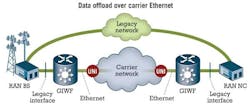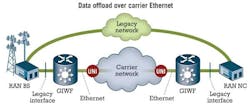By Paul Marshall
Service verification for backhaul ensures a better customer experience for mobile users. The selection of the correct tools plays a critical role.
The proliferation of smartphones and other next-generation mobile broadband devices has led to the explosive growth of data in mobile networks. Wireless operators now realize the only way to keep up with this relentless demand for more bandwidth is to upgrade their backhaul infrastructure. Managing this upgrade efficiently requires that operators perform thorough validation of their new connections. Providing field technicians with flexible, expert service verification tools to streamline this process not only reduces the costs to deploy the new capacity but also increases the quality of the mobile backhaul network, which directly improves end-user experience.
Figure 1. The Metro Ethernet Forum’s MEF 22 Mobile Backhaul Implementation Agreement offers four ways for operators to implement Carrier Ethernet for wireless backhaul. The first method is to use a Carrier Ethernet infrastructure in the radio access network (RAN) to offload data services from the legacy backhaul network.
Ethernet backhaul for next-gen services
Fourth Generation (4G) WiMAX and Long Term Evolution (LTE) provide an advanced wireless broadband platform that supports a host of broadband-enabled applications, including Internet access, video, gaming, voice, and other services. According to ABI Research, consumer-generated 4G mobile service revenues are expected to exceed $70 billion worldwide by the end of 2014. Revenues from 4G mobile service for enterprise customers are forecasted to reach $43 billion in four years, says the research firm.
The bandwidth for mobile data over 4G will be significantly greater for current generation mobile network technologies. For example, Clearwire in 2009 launched its 4G WiMAX service that delivers average mobile download speeds between 3 Mbps to 6 Mbps, with bursts reaching more than 10 Mbps.
Recently, Verizon Wireless reported that a trial of its LTE capabilities found the service can sustain average data rates of 5–12 Mbps downstream and 2–5 Mbps upstream, with peak download speeds reaching 40–50 Mbps and peak upload speeds at 20–25 Mbps. Verizon plans to launch LTE in 25 to 30 markets by the end of the year. Its competitor in the space, AT&T, plans to roll out its LTE capabilities in 2011.
By comparison, AT&T’s recent HSPA+ upgrades of its national mobile network support data speeds of about 3.6 Mbps, with some speeds topping out at 7.2 Mbps. Estimates put data rates for AT&T’s earlier generation HSPA at around 3.6 Mbps downstream. Also, 3G data speeds for Verizon are about 1.5 Mbps downstream, with bursts topping 3 Mbps.
As a result of this bandwidth growth, the infrastructure backhauling all this traffic from cell towers to the core network also needs to grow significantly larger to prevent data traffic logjams. Operators are deploying Carrier Ethernet to significantly expand backhaul capacity. Where cell sites today might be supporting two to four T1 lines at an aggregate backhaul bandwidth of 3 to 6 Mbps, Carrier Ethernet enables for the cost-effective deployment of 100-Mbps or 1-Gbps backhaul links. The mobile operator can purchase just the required information rate and flexibly scale that data rate as user traffic demands, without deploying more physical links.
A 1-Gbps line configured with a committed information rate of 20 Mbps for a single base station can be grown by a factor of roughly 40 before the capacity of the physical link is exhausted. This sort of automatically provisioned capacity growth in the physical plant is just what mobile operators sorely need as they struggle to cope with traffic growth in the multiple hundreds of percent per year. This dramatic growth in capacity with Carrier Ethernet naturally also includes a significant drop in bandwidth cost-per-bit for data-intensive smartphones.
The benefits of Carrier Ethernet backhaul are expected to boost use of the technology in the coming years. Infonetics Research says worldwide Ethernet backhaul services will add more than 1 million new or converted connections between 2009 and 2011.
There are unique requirements for testing and monitoring Carrier Ethernet backhaul infrastructure. Backhaul operators want end-to-end visibility of the network and backhaul platforms to quickly identify problems and decrease the time needed to repair and re-establish service. Also, operators want to perform Ethernet verification tests from a central location. Finally, service providers want their network and service technicians to have efficient and capable tools that can quickly lead to the diagnosis of local problems and the verification of effective corrections.
Best practices in Ethernet backhaul operations mandate continuous performance monitoring on multiple levels. Carrier Ethernet services are optimized for packet data delivery, which requires constant monitoring to verify end-to-end service performance to the SLA. Also, Ethernet backhaul comprises diverse transport infrastructures, such as fiber networks, copper connections, and microwave. These supporting transport networks also require continuous performance monitoring to:
a. give an early warning of impending failure for a slowly developing problem,
b. enable an immediate automated switch to standby facilities in the event of a circuit outage,
c. quickly facilitate fault management activities when a circuit fault occurs.
Figure 3. MEF 22 also specifies the use of dual TDM/Ethernet stacks as the third option for wireless backhaul.
Another area of concern between the mobile operator and the Carrier Ethernet backhaul provider is the maintenance of precise timing synchronization between base stations. Precise timing synchronization enables live cell phone calls to be switched efficiently from station to station as the mobile customer travels through the network. Timing must be synchronized to the point where the customer hears no audible clicks due to the delay between one base station ceasing service and the next starting it, and to the point of avoiding a dropped call at the hand off.
Techniques are available to maintain synchronization between base stations connected with Carrier Ethernet facilities, and the operation of this synchronization sometimes needs to be verified. Further, many users of backhaul service are quite sensitive to the delay introduced by the backhaul circuit, and are especially concerned that a switch to Carrier Ethernet from TDM-based transport may significantly increase the transport delay. Mobile backhaul service providers need to demonstrate through actual measurements that their Carrier Ethernet service provides no degradation to circuit latency.
In addition, Ethernet backhaul requires a high level of service management due to its stringent performance requirements. Operators want detailed reports and test results on the performance of their Ethernet-supported backhaul infrastructure. Data on the performance of backhaul circuits is crucial for managing class of service needs, especially class-of-service uses in a Carrier Ethernet environment.
Class of service assigns a priority value to traffic on a network. It helps alleviate network congestion while ensuring data reaches an end-user in an efficient and timely manner according to the varying needs of each customer. Class of service for backhaul enables operators to manage their traffic needs. Test and measurement for backhaul helps an operator to determine if its infrastructure is meeting performance expectations.
Recently enacted specifications from the Metro Ethernet Forum (MEF) will help operators manage Carrier Ethernet-supported backhaul. In 2008, the organization released its long-awaited MEF 22 Mobile Backhaul Implementation Agreement. This technical specification provides service providers with a number of Carrier Ethernet-based approaches for deploying mobile backhaul networks (see Figures 1 through 4). These new high-performance services require rigorous service verification to be deployed effectively by field technicians.
Figure 4. When an operator has completed its evolution from TDM-based infrastructure—deployed in a greenfield application—all traffic is packet based end-to-end, which enables the operator to enjoy the efficiencies of Carrier Ethernet throughout the backhaul network.
Also, several service providers worldwide have achieved MEF 9 and MEF 14 certifications, an accomplishment that confirms the quality and reliability of their point-to-point, point-to-multipoint, and multipoint-to-multipoint Ethernet services. As they expand their slate of Ethernet-supported services, including backhaul, these operators need Carrier Ethernet-compliant testing and monitoring equipment to verify they are delivering top-notch quality of service.
And while Carrier Ethernet will likely dominate backhaul’s future, test and measurement of next-generation backhaul services can’t focus exclusively on Ethernet capabilities. Service verification for backhaul also applies to PDH or SONET/SDH networks. While backhaul operators roll out new technology to support next-generation mobile services, they also are likely to keep some of their current infrastructure in place, including TDM switched circuits.
Backhaul testing implementation
For this reason, besides having the flexibility and functionality to test and monitor backhaul across different technologies, operators need service verification capabilities that help manage their transition from old to new technology. This conversion requires flexible, future-proof test and measurement approaches that enable field technicians to install, verify, maintain, and troubleshoot different types of backhaul circuits. A single instrument that enables engineers and field personnel to easily and quickly see if backhaul capabilities are working properly and that covers both Ethernet and legacy circuits can save time and money for the operator, while increasing technician productivity.
Operators build their maintenance systems supported by three pillars — performance monitoring, remote testing, and local testing. They build performance monitoring capability into the network elements to enable the collection of data that facilitates management reporting for long-term network quality management, as well as short-term alarm reports to drive the rest of the maintenance system. When the performance monitoring system delivers an alarm, the remote testing system kicks in to give an automated diagnosis of where the fault is located so a responsible maintenance organization can be dispatched to correct the problem. Once on site to correct the problem, the technician needs appropriate tools to diagnose the problem quickly and accurately, and to verify that any corrective action has been effective before leaving the site.
Therefore, backhaul test tools must work in harmony with the rest of the operators’ maintenance strategy. Performance monitoring and remote testing functions are sometimes built into the same network elements; the technician’s tools should be able to take advantage of functionality in the network to save time and effort.
The rise of Carrier Ethernet is spawning a new generation of Ethernet service activation test standards within the International Telecommunications Union (ITU). It is important for service providers that their test equipment supports the early drafts of standards now in development as well as older, more traditional standards that have been in place for years.
Finally, companies that regularly test and monitor their backhaul infrastructure need tools that are easy to understand and operate. Service verification instruments with a simple, single interface are crucial for maintaining technician productivity. Backhaul infrastructure and the mobile networks they support contain a tremendous array of technologies that can easily confuse and intimidate the technician. The right mix of functionality and ease-of-use significantly simplifies backhaul testing and monitoring for engineers and field technicians.
Service verification a priority
Backhaul service verification has become a mission-critical priority as the demand grows for advanced mobile services. As backhaul operators migrate to Ethernet from a TDM switched circuit environment, they will need unified service verification tools that are easy to use and can enhance workforce productivity.
Cost-effective test and measurement platforms will help address backhaul demands, giving operators the assurances they need that their backhaul infrastructure meets strict service performance requirements and can deliver the advanced services mobile users demand.
Six months ago when we surveyed operators around the world, most were taking a dual/hybrid backhaul approach (TDM plus IP/Ethernet).”
Paul Marshall is chief technology officer at Sunrise Telecom.




